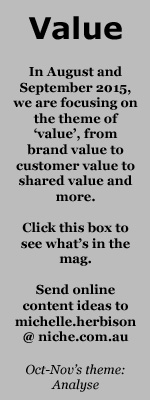What version marketing operating system are you running?
Share
Sheryl Pattek discusses the MOS framework, where a fluid marketing operating system framework takes the place of rigid structures.
 Technology has dramatically changed the relationship between brands and customers, shifting the power dynamic into the hands of the consumer – who is now empowered by technology to take control of her buying journey. As a result, Forrester contends we are operating in the age of the customer, where the only sustainable competitive advantage for firms is knowledge of and engagement with these empowered customers.
Technology has dramatically changed the relationship between brands and customers, shifting the power dynamic into the hands of the consumer – who is now empowered by technology to take control of her buying journey. As a result, Forrester contends we are operating in the age of the customer, where the only sustainable competitive advantage for firms is knowledge of and engagement with these empowered customers.
To succeed in the age of the customer, two elements are essential:
 A customer-obsessed approach to defining the business and marketing strategy, and
A customer-obsessed approach to defining the business and marketing strategy, and- an in-depth understanding of customers’ behaviours and needs.
But an emphasis on responding to changing customer needs isn’t just a way to engage new customers in new ways. It’s an opportunity to rethink how marketing is done from scratch, examine the way marketing does its work, and redefine traditional marketing roles and responsibilities.
Where does this journey begin? The onus is now on CMOs to move beyond the hierarchical product silos or channel-obsessed marketing organisational structures put in place decades ago.
To thrive in this customer-controlled era, CMOs must build a new organisation model with a customer-first foundation – a model that obsesses about the customers the business serves, and only serves those over whom they can obsess.
Old rigid organisation structures must give way to a fluid marketing operating system (MOS) framework. The MOS approach does more than just move labels around an organisation chart – it creates an adaptable design with more collaboration across marketing channel silos to execute strategy faster, with more flexibility. The MOS provides the foundation that ties marketing systems, processes and outcomes together, nimbly moving a marketing organisation toward customer obsession.
In the MOS, a customer’s vision of her needs and the enterprise’s view fuse together, aligning all marketing actions to satisfy the needs with a singular purpose – winning, serving, and retaining customers.
Now is the time to reboot existing marketing organisation structures with an MOS-based approach because:
- Customers demand consistency. In our digitally connected world, empowered consumers expect to move seamlessly between marketing channels, devices, and experiences. And marketing organisations must make sure they meet these expectations with an agile and fluid experience.
- Marketing efficiency requires coordinated efforts. Silos and channel-based structures inhibit efficient and flexible interactions with customers. Marketing organisation structures must now prioritise customer relationships over marketing channel performance. A coordinated and agile organisational design will enhance marketing effectiveness and customer engagement.
- Analytics offer a competitive edge. The connected world offers the potential for rich data analytics on every customer action. To keep pace with peers, marketers must be able to act on deep customer insight using marketing technology in a consistent way across the organisation. While the MOS provides the structure for marketing teams to prosper in the age of the customer, it also requires new roles at both the leadership and the facilitator levels to make the organisation function at its best. Tune the MOS-based organisation structure for customer obsession by adding:
- Five new roles to power the MOS. CMOs will execute strategy faster, with more flexibility and adaptability, by adding five new marketing roles to their team: customer segment owners, marketing technologists, a content chief, process managers and operations managers. Each one helps fill a void that exists in traditional organisation structures.
- Customer segment owners to lead the customer engagement charge. Appoint customer segment owners whose job is to match customers’ needs to your products, services and go-to-market tactics. These segment owners will prioritise contextually relevant customer experiences ahead of marketing channel optimisation.
- A strong marketing technology partner to thrive. Proactively embrace and wield technology and associated processes as a native capability in marketing strategy and tactics to fuel the MOS. Unite the leadership of processes, technical capabilities, and digital platforms under a single umbrella – a marketing technology office (MTO). The MTO will bridge marketing needs and internal technology management capabilities.
Many of the CMOs and marketing leaders I talk with are looking for better ways to organise their team, to enhance customer engagement and improve marketing efficiency. Moving boxes around existing marketing structures just won’t get you there any longer. Implementing a MOS is hard work, however, as the organisation must adopt new attitudes and paradigms. The CMO’s leadership will make all the difference in how the marketing team accepts and excels in the new MOS environment. Effectively manage the transformation process and your organisation will thrive, executing strategy faster, with more flexibility and adaptability to win, serve and retain your customers.
Sheryl Pattek is vice president and principal analyst at Forrester Research.
Forrester is a Marketing content partner – non-commercial collaborations with leading organisations on content for the magazine (like this article) as well as exclusive benefits for Marketing Advantage Members. Click here for more information.















